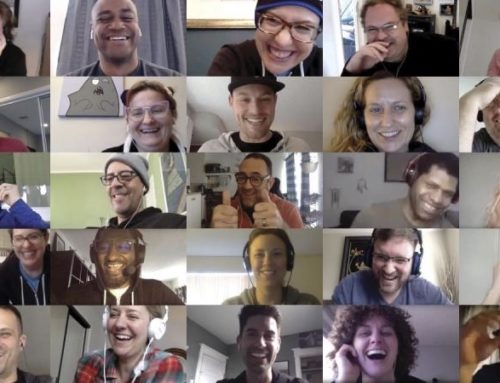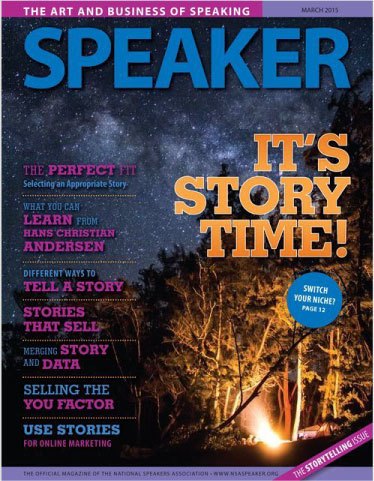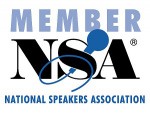Whether you are working from home, or leading a remote team, your executive presence is going to be judged through a computer screen. To give you an edge, let’s unpack what makes for strong screen, or virtual presence.
Before I was a keynote speaker, I worked as a professional actress, and here’s what I learned from Hollywood about being camera ready. First, the fundamentals:
Lighting
Any photographer will tell you that overhead lighting casts an unflattering shadow on your face. The paparazzi set up their lights in front of the subject. This same thing can be accomplished at home by simply placing two desk lamps on both sides of your computer.
If you are a little more ambitious you can get small LED video lights for about $25.00 bucks and mount them on inexpensive tripods. Or, invest in a ring light.
Background
Keep it clean and simple. On video, we not only see other people, we take in their environments. If you’re on a call with six colleagues, it’s like you’re in six rooms simultaneously.
Your eye will get drawn to their file cabinets, the books in their bookcases, and the picture of their Uncle Fred. I’ve even found myself straining to read certificates hanging on someone’s back wall. If our eyes see it, our brains will want to process it.
To focus your viewer’s attention, keep your background simple—but not too personal or sterile. No bedrooms. I know, those pillows shams are straight out of Better Homes & Gardens, but it just doesn’t look like you’re at work. Kitchens tables are okay, but make sure there are no dirty dishes in the background.
Beware of a totally blank wall though, it will seem like you are imprisoned or in a hospital.
A wall with a few paintings, or some houseplants on a table behind you will create a warm, but not distracting backdrop.
If you are using a virtual background, the same rules apply. Keep it simple.
Framing
Beware of too much space above your head on the screen. A film director once told me: “Nothing interesting ever happens on the ceiling.”
There is a temptation to frame your face dead center. Visually it’s more appealing to be a little right of the center of the screen. Bonus points for something simple in the background being revealed over your left shoulder.
Wardrobe
Don’t wear clothing or jewelry that steals focus. Make sure your wardrobe contrasts with your background. If you wear a blue shirt against a blue wall, you’ll end up looking like a floating head in a box.
Whatever you do, avoid busy patterns. Checkerboard designs and tiny, little strips create a vibration in the image that’s hard on the eyes. Solid colors work the best but avoid wearing all black or all white.
And, pick a color that compliments your skin tone. I have olive undertones in my complexion, so yellow makes me look a little bit jaundiced on camera. Jewel tones look nice on most people.
And ladies, avoid noisy bracelets or dangly earrings. They distract from the star of the show—you, and your message.
More important than all of the above though is your ability to project authenticity & emotion through the camera lens when you are making a presentation.
Eye Contact
Place your webcam just above eye level. The viewer will feel like you are looking straight at them, just like during an in-person meeting. If your camera is positioned too high it will feel as if you are looking up their noses. If it is placed too low, they will feel like they are looking up your nose!
Don’t look at the computer screen when you are speaking, look into the camera. This gives your viewer (notice I didn’t say audience) the experience of direct eye contact.
Shrink your video window and move it to the top of your screen, just under your webcam, then look at the image of the other person when they are speaking.
Alignment
Give thought to what you want each individual viewer to feel at each moment of your talk or presentation.
For example: off the top you might want them to
- feel welcomed, then when you tee up the business problem you are going to help them solve
- you might want them to feel a little panicky
- and finally you’ll want them to feel reassured that you’ve provided a powerful solution
- and energized to make a change.
At each of these moments in your talk make sure your gestures and facial expression and stories are in alignment with those emotional choices.
If you are trying to get them to feel a little panicky about the business problem and you are smiling, you’ll lose credibility.
Facetime
Your face is more interesting than any slide you’ll ever create.
Audience
Stop thinking about your audience as a group. This is a mindset shift. In the virtual world we are not talking to a group, we are talking to a number of individuals—simultaneously.
For example:
“Okay everyone let’s imagine that we are….”
This wording works really well when 200 people are sitting side-by-side in an auditorium. But there is no ‘everyone’ when your client or colleagues are watching you virtually.
This wording is better and more intimate:
“I want YOU to imagine that we are….and while YOU’RE picturing this, be aware that 199 of your colleagues are right now doing the same thing.”
Camera
Building on the last point. Think of the camera as a good friend. While you are looking into the barrel of the lens, pretend you are giving your talk to one person who really needs your help and is totally enraptured with what you are saying.
The more you can conjure up the feeling of connection with a real person, the more the viewer at home will FEEL your warmth on their screen—and that’s how to improve your telepresence!
Always use the Online HTML Beautifier to compose the content for your website easily.
















